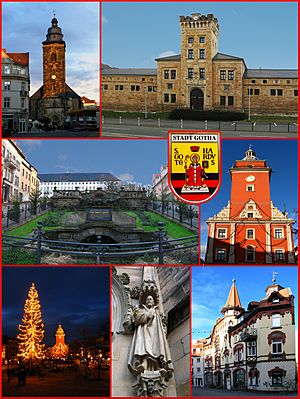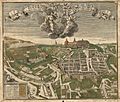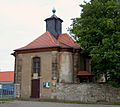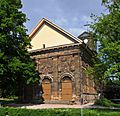Gotha facts for kids
Gotha is a town in Thuringia, a state in Germany. It's the main city of the Gotha area. In 2015, about 45,410 people lived there.
Quick facts for kids
Gotha
|
||
|---|---|---|

Top left: St Margarethen, Top right: Marstall, Middle left: Water feature in front of Friedenstein Castle, Middle right: Rathaus Gotha in Hauptmarkt, Bottom left: View of Christmas illumination event in Hauptmarkt, Bottom centre: Porch in St Margarethen Church, Bottom right: Bruhl Street
|
||
|
||
| Country | Germany | |
| State | Thuringia | |
| District | Gotha | |
| Elevation | 300 m (1,000 ft) | |
| Population
(2022-12-31)
|
||
| • Total | 46,019 | |
| Time zone | CET/CEST (UTC+1/+2) | |
| Postal codes |
99867
|
|
| Dialling codes | 03621 | |
| Vehicle registration | GTH | |
| Website | www.gotha.de | |
Contents
Gotha's Long History
Gotha is a very old town! It has been around since at least the 8th century. Its name was first written down in a document signed by Charlemagne, a famous emperor. Back then, it was called Villa Gotaha, which means "Good Waters."
Gotha as a Capital City
In 1640, Gotha became the capital city of a place called Saxe-Gotha. Later, from 1826 to 1918, it was one of the two capitals of the Duchy of Saxe-Coburg and Gotha. This means it was a very important place for rulers and their families.
A Center for New Ideas
In the 1700s, a famous French thinker named Voltaire spent a lot of time in Gotha. The royal court there became a key spot for the Enlightenment in Germany. This was a time when people started to think more about science, reason, and human rights.
Gotha and Workers' Rights
Gotha also played a big part in Germany's workers' movement. In 1875, the German socialist party (SPD) was started in Gotha. This happened when two groups, the Social Democratic Workers' Party and the General German Workers' Association, decided to join forces. Their agreement was known as the Gotha Program.
A Hub for Publishing
Gotha has always been known for its publishing companies. A company called Justus Perthes (now Hermann Haack) started publishing the Almanach de Gotha in 1763. This almanac was a super important book that listed all the major ruling families and noble people in Europe.
Gotha in East Germany
From 1949 to 1990, Gotha was part of the German Democratic Republic. This was a time when Germany was divided into two separate countries.
What to See in Gotha
Gotha has many interesting places to visit!
- Schloß Friedenstein: This is the main attraction in Gotha. It's a huge former palace built between 1643 and 1655. It's Germany’s oldest early Baroque palace, which means it has a very fancy and grand style. Inside, you'll find the Museum of Regional History and the historic Ekhof Theatre. This theatre is the oldest preserved baroque theatre in the world!
- Town Hall: This building was built between 1567 and 1577 in a Renaissance style. Look closely at its north side; it has a really detailed and decorated front.
- Market Place (Hauptmarkt): This is a lively square surrounded by old houses that have been beautifully restored. Many of them have cool Baroque doorways.
- Augustinian Church: This church was built in the 13th century in the Gothic style. It used to be part of an abbey.
- St Margaret’s Church (Margarethenkirche): This church dates back to the late 15th century.
- Freakstock Festival: Gotha also hosts the annual Freakstock Christian music festival, which is a big event for music lovers.
Gotha's Sister Cities
Gotha has special friendships with other cities around the world. These are called sister cities:
- Martin, Slovakia
- Gastonia, North Carolina, USA
- Kielce, Poland
- Romilly-sur-Seine, France
- Salzgitter, Germany
Images for kids
-
Neoclassical cup with saucer from Gotha, late 18th century, hard-paste porcelain
See also
 In Spanish: Gotha para niños
In Spanish: Gotha para niños










































